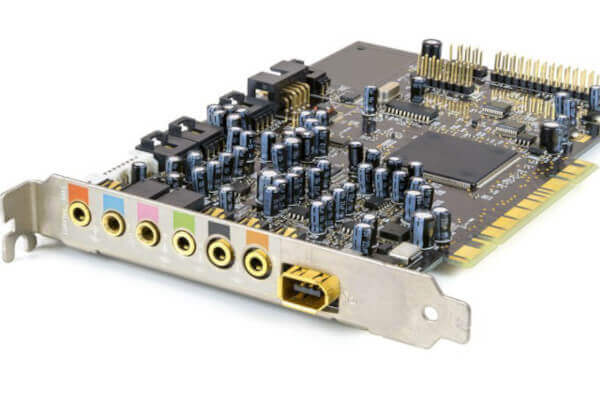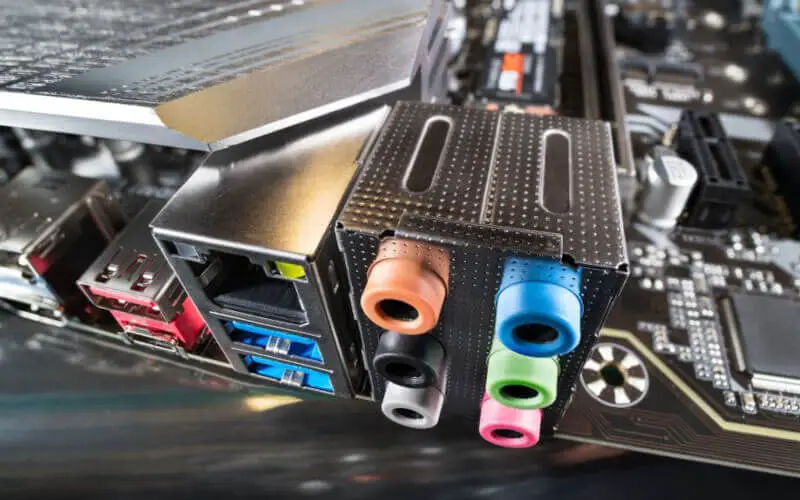Today, we’ll discuss two important components of your computer’s audio setup: onboard audio and sound cards. If you’re passionate about music or want to enjoy an immersive audio experience, you might have come across these two terms before.
But what exactly are they, and how do they differ? That’s what we’ll be exploring in this article.
As someone who’s been building computers for a while now, I’ve come across many people who are often confused between the two and can’t decide which one to go for. I am writing this article to assist you in making an educated, informed decision.
Whether you’re a gamer, a content creator, or just someone who wants better audio quality, this article will give you a good idea of what to expect from each option.
Let’s get started!
What is Onboard Audio?
Onboard audio refers to the audio processing unit built directly onto your motherboard. In other words, it’s a standard feature of modern motherboards, and you don’t need to purchase a separate sound card. One of the biggest advantages of onboard audio is that it’s cost-effective.
Since it’s integrated into your motherboard, you don’t have to spend extra money on a sound card, making it a great option for budget-conscious users.
Additionally, it’s also incredibly convenient since it doesn’t require any additional hardware or complicated installation processes. You plug in your speakers or headphones, and you’re good to go!
However, there are some limitations to using onboard audio. The biggest one is the quality of sound. Onboard audio is designed to provide basic functionality but cannot produce high-quality audio like a dedicated sound card.
This can be a drawback for audiophiles and those who want the best audio quality possible. Additionally, onboard audio also lacks customization options. You can’t fine-tune the sound to your liking, and you’re stuck with what you get.
Onboard audio is an excellent option for those strapped to a budget who don’t require top-notch sound quality. It’s convenient, cost-efficient, and easy to use; however, it won’t be suitable for anyone looking for superior audial excellence.
What is a Sound Card?

A sound card is a separate hardware component that you add to your computer to improve the audio quality. It is an intermediary between your computer and your speakers or headphones, providing higher-quality audio processing.
A sound card’s biggest advantage is its improved sound quality. A dedicated sound card has its own audio processing unit specifically designed to produce high-quality audio.
This means that you’ll get a more immersive audio experience compared to onboard audio. Another advantage is customization. With a sound card, you can fine-tune the audio to your liking, making it ideal for audiophiles who want complete control over their audio.
However, sound cards come with some disadvantages as well. The biggest one is cost. Sound cards can be quite expensive, and purchasing one can be a significant investment. Additionally, adding a sound card also means adding another hardware component to your computer, which can be inconvenient for some users.
If you’re an audiophile or a gamer seeking to create an immersive and superior soundscape, consider investing in a sound card. On the other hand, if your budget is limited or requires basic audio preferences – onboard solutions are more than suitable.
Difference Between Onboard Audio and Sound Card
Now that we’ve discussed both onboard audio and sound cards let’s compare the two.
Sound quality is one of the most important factors when choosing between onboard audio and a sound card. Onboard audio provides basic functionality, but it can’t produce high-quality audio as a sound card can. A sound card is a way to go if you value sound quality.
Cost is another factor to consider. Onboard audio is built into your motherboard, so you don’t have to spend extra money on a sound card. This makes it a cost-effective option for budget-conscious users. On the other hand, sound cards can be expensive, making them a significant investment.
Customization is also an important consideration. With onboard audio, you don’t have much control over the sound, but with a sound card, you can fine-tune the audio to your liking. This makes sound cards ideal for audiophiles who want complete control over their audio experience.
Convenience is another factor to consider. Onboard audio is integrated into your motherboard, making it incredibly convenient. You plug in your speakers or headphones, and you’re ready. On the other hand, a sound card requires additional hardware, which can be inconvenient for some users.
Conclusion
Onboard audio and sound cards have their advantages and disadvantages. It’s important to consider factors such as sound quality, cost, customization, and convenience when choosing between the two.
Onboard audio is a cost-effective option that provides basic audio functionality. It’s convenient to use but can’t produce high-quality audio and lacks customization options.
On the other hand, a sound card provides high-quality audio and allows you to fine-tune the sound to your liking. However, it can be expensive and requires additional hardware.
Ultimately, the choice between onboard audio and a sound card depends on your personal needs and preferences. A sound card might be the way to go if you value sound quality and customization. But onboard audio is a great option if you’re on a tight budget and want basic audio functionality.






